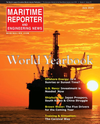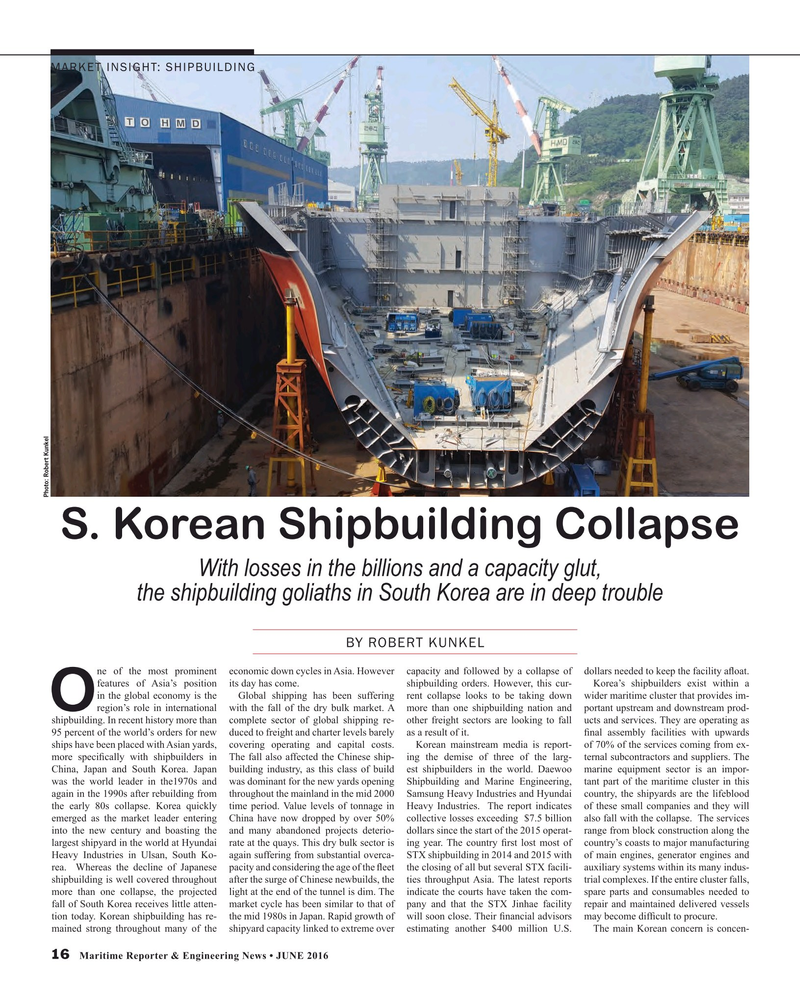
Page 16: of Maritime Reporter Magazine (June 2016)
Annual World Yearbook
Read this page in Pdf, Flash or Html5 edition of June 2016 Maritime Reporter Magazine
MARKET INSIGHT: SHIPBUILDING
Photo: Robert Kunkel
S. Korean Shipbuilding Collapse
With losses in the billions and a capacity glut, the shipbuilding goliaths in South Korea are in deep trouble
BY ROBERT KUNKEL ne of the most prominent economic down cycles in Asia. However capacity and followed by a collapse of dollars needed to keep the facility a? oat. features of Asia’s position its day has come. shipbuilding orders. However, this cur- Korea’s shipbuilders exist within a in the global economy is the Global shipping has been suffering rent collapse looks to be taking down wider maritime cluster that provides im-
Oregion’s role in international with the fall of the dry bulk market. A more than one shipbuilding nation and portant upstream and downstream prod- shipbuilding. In recent history more than complete sector of global shipping re- other freight sectors are looking to fall ucts and services. They are operating as 95 percent of the world’s orders for new duced to freight and charter levels barely as a result of it. ? nal assembly facilities with upwards ships have been placed with Asian yards, covering operating and capital costs. Korean mainstream media is report- of 70% of the services coming from ex- more speci? cally with shipbuilders in The fall also affected the Chinese ship- ing the demise of three of the larg- ternal subcontractors and suppliers. The
China, Japan and South Korea. Japan building industry, as this class of build est shipbuilders in the world. Daewoo marine equipment sector is an impor- was the world leader in the1970s and was dominant for the new yards opening Shipbuilding and Marine Engineering, tant part of the maritime cluster in this again in the 1990s after rebuilding from throughout the mainland in the mid 2000 Samsung Heavy Industries and Hyundai country, the shipyards are the lifeblood the early 80s collapse. Korea quickly time period. Value levels of tonnage in Heavy Industries. The report indicates of these small companies and they will emerged as the market leader entering China have now dropped by over 50% collective losses exceeding $7.5 billion also fall with the collapse. The services into the new century and boasting the and many abandoned projects deterio- dollars since the start of the 2015 operat- range from block construction along the largest shipyard in the world at Hyundai rate at the quays. This dry bulk sector is ing year. The country ? rst lost most of country’s coasts to major manufacturing
Heavy Industries in Ulsan, South Ko- again suffering from substantial overca- STX shipbuilding in 2014 and 2015 with of main engines, generator engines and rea. Whereas the decline of Japanese pacity and considering the age of the ? eet the closing of all but several STX facili- auxiliary systems within its many indus- shipbuilding is well covered throughout after the surge of Chinese newbuilds, the ties throughput Asia. The latest reports trial complexes. If the entire cluster falls, more than one collapse, the projected light at the end of the tunnel is dim. The indicate the courts have taken the com- spare parts and consumables needed to fall of South Korea receives little atten- market cycle has been similar to that of pany and that the STX Jinhae facility repair and maintained delivered vessels tion today. Korean shipbuilding has re- the mid 1980s in Japan. Rapid growth of will soon close. Their ? nancial advisors may become dif? cult to procure.
mained strong throughout many of the shipyard capacity linked to extreme over estimating another $400 million U.S. The main Korean concern is concen- 16 Maritime Reporter & Engineering News • JUNE 2016
MR #6 (10-17).indd 16 6/6/2016 12:22:01 PM

 15
15

 17
17
